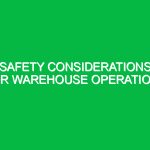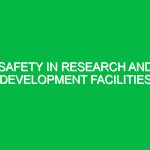Introduction
In today’s world, the use of chemicals is ubiquitous, whether in industrial settings, laboratories, or even at home. From cleaning products to industrial solvents, understanding Safe Practices for Working with Chemicals is crucial for ensuring health, safety, and environmental well-being. The Health, Safety, and Environment (HSE) domain emphasizes that proper handling and management of chemicals can significantly reduce risks associated with exposure, spills, and accidents. This article delves into the various facets of safe chemical practices, highlighting the importance of awareness, training, and adherence to regulations.
Understanding the Hazards and Risks
When working with chemicals, several hazards are inherent, and recognizing these is the first step towards safe practices. Chemical hazards can be broadly classified into categories such as:
1. Toxicity
Toxic chemicals can cause serious health issues upon exposure, whether through inhalation, ingestion, or skin contact. For instance, substances like benzene and formaldehyde are known carcinogens. A personal experience from a colleague in the chemical industry underscored this risk when he suffered from respiratory issues after prolonged exposure to a poorly ventilated workspace.
2. Flammability
Flammable chemicals can ignite, causing fires or explosions. For example, solvents like acetone and ethanol pose significant risks. A notable incident in a laboratory setting involved a small fire due to a broken fume hood, which could have been avoided with better safety practices.
3. Corrosiveness
Corrosive substances can damage skin, eyes, and respiratory tracts. Acids and bases often fall into this category. A case study from a manufacturing plant highlighted how improper storage of corrosive materials led to serious injuries among workers.
4. Environmental Impact
Chemical spills can have catastrophic effects on the environment. For instance, the Deepwater Horizon oil spill serves as a stark reminder of how chemical hazards extend beyond human health to impact ecosystems profoundly.
5. Reactivity
Certain chemicals can react violently with others, leading to dangerous situations. An anecdote from a chemical engineer involved a mixing incident where improper handling resulted in a toxic gas release, emphasizing the need for vigilance and proper training.
Safety Precautions and Best Practices
To mitigate the risks associated with chemical work, adhering to safety precautions is paramount. Below are essential practices to consider:
1. Conduct a Risk Assessment
Before engaging in any chemical work, it is crucial to conduct a thorough risk assessment. Identify the chemicals involved, evaluate their hazards, and determine who may be affected. This proactive approach allows for tailored safety measures.
2. Use Personal Protective Equipment (PPE)
Appropriate PPE is vital in protecting against chemical exposure. This includes gloves, goggles, face shields, and lab coats. For instance, when handling corrosive substances, rubber gloves and face shields can prevent severe injuries. In my experience, wearing the correct PPE has made a significant difference in maintaining safety in high-risk environments.
3. Implement Proper Storage Practices
Storage of chemicals must adhere to specific guidelines to prevent accidents. Chemicals should be stored in clearly labeled, appropriate containers, and incompatible substances should never be stored together. For example, acids and bases should be kept in separate areas to avoid dangerous reactions.
4. Ensure Adequate Ventilation
Working with volatile or toxic substances requires proper ventilation. Fume hoods and exhaust systems are essential in laboratories and industrial settings. A friend who worked in a chemical plant once recounted how a malfunctioning ventilation system led to a near-miss incident that could have resulted in serious health effects.
5. Provide Training and Education
Regular training on safe chemical practices is essential for all employees. This should include knowledge of Material Safety Data Sheets (MSDS), which provide critical information about chemical hazards and safe handling procedures. I recall a training session that highlighted the importance of understanding these sheets, leading to increased awareness and reduced incidents in the workplace.
6. Maintain Emergency Preparedness
Have an emergency response plan in place. This should include spill response protocols, first aid procedures, and evacuation routes. Regular drills can help ensure that everyone knows their role in an emergency. An incident from a local lab demonstrated that a well-rehearsed emergency plan can save lives during unexpected chemical spills.
Regulations and Standards
Compliance with regulations is a cornerstone of safe chemical practices. Various organizations and regulations govern chemical safety, including:
1. Occupational Safety and Health Administration (OSHA)
OSHA provides guidelines for chemical safety in the workplace, including permissible exposure limits and the Hazard Communication Standard, which mandates proper labeling and employee training.
2. Environmental Protection Agency (EPA)
The EPA regulates chemical substances under the Toxic Substances Control Act (TSCA), ensuring that chemicals are assessed for their potential risks to human health and the environment.
3. American National Standards Institute (ANSI)
ANSI develops standards related to chemical safety procedures and equipment, providing guidelines to ensure safe operations across various industries.
4. Globally Harmonized System (GHS)
The GHS is an international standard for classifying and labeling chemicals, aimed at improving safety through consistent communication of hazards.
Conclusion
In summary, implementing Safe Practices for Working with Chemicals is vital for protecting health, safety, and the environment. By understanding the hazards, adhering to safety precautions, and complying with regulations, individuals and organizations can significantly reduce the risks associated with chemical work. A culture of safety, continuous education, and vigilance can lead to safer workplaces and healthier communities. Remember, safety is not just a priority; it’s a responsibility.


